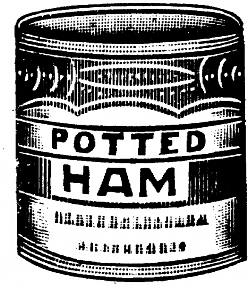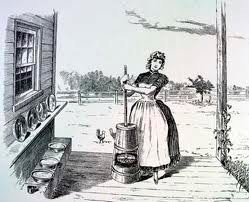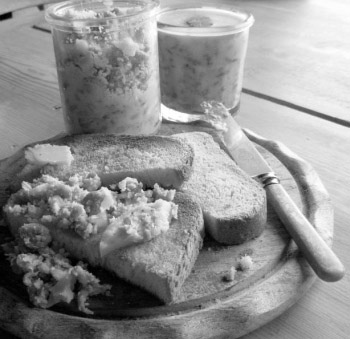The potter’s products; a select sample of eleven recipes from Pottery by A Potter.

One of the rare pots bound with pork:
“YORKSHIRE MEAT PASTE½ lb each lean beef and lean bacon: 1 cup water or stock; Yorkshire Relish and black pepper to taste.Mix all ingredients together; place in a battered pudding basin, cover with a buttered paper and steam 3 hours in a saucepan of boiling water that comes half way up the bowl. Pour off gravy into a bowl. Pound meat, moistening with the gravy as required. Season to taste, press into small jars and cover with clarified butter. For breakfast this makes quite a good sausage.”
Notes:
-If you lack a pudding basin, use a sturdy bowl of appropriate size.
-The specified cooking time is long; once the meat is fork tender it can be removed, usually in about two hours.
-Do mash the meat with a food processor instead of mortar and pestle. A Potter would have done the same thing had processors existed in 1946.
-Do not use water instead of stock.
-‘Yorkshire Relish’ refers to Henderson’s relish, still made today but difficult to find outside Yorkshire and nearly impossible in the United States (available by mail direct from Henderson’s but the shipping is costly). Nothing, however, is lost, because Henderson’s is essentially Worcestershire without anchovy. You will lose the vegan element of the sauce but nothing more, and the nonvegan component of this pot renders the distinction moot.
-It is arbitrary, or perhaps whimsical, of A Potter to call this pot a paste.
-More characteristic of the English style, and for the (slightly) more adventuresome:
“MEAT PASTE
Beef Steak ¾ lb; Sheep’s kidneys 2; Butter ¼ lb; Mace 1 teaspoon; Nutmeg 1 do.; Cayenne Pepper ½ do.; Salt 1 do.; Anchovy Sauce 1 tablespoon.
Cut meat into pieces of about 2 inches and put all ingredients into a jar in a saucepan with hot water, and cook for 5 hours. When cooked take meat out and put through a mincer three times. Then add liquid and put in small jars.
Take care not to have any little pockets of air when putting in pots. Will keep some time.” (‘Potter’ 5)
Notes:
-‘Do.’ is “ditto” unnecessarily abbreviated but not an uncommon archaic usage. More fogeyism from A Potter.
-Note the vast amount of spice; not a typographical error but evidence of how highly seasoned most pots should be.
-Cooking everything together in a jar has alchemical effect; it transforms and concentrates the flavors in a remarkable manner. Tuscans do the same thing when cooking cannellini with aromatics. The technique creates an exceptional pot.
-You should not, however, require anything close to five hours.
-Anchovy sauce like Henderson’s relish is difficult, even more difficult, to find everywhere. A mashed anchovy or scant 2 teaspoons anchovy paste may impersonate it with conviction.
-Do not fear kidney: In this pot it is indiscernible. Along with the anchovy, it only serves to render the beef beefier. About a quarter of a veal kidney or half a pork kidney could understudy for the sheep’s.
-This pot is a bit of misnomer; pedants would protest that kidney in strictest terms is offal rather than meat. An unusual slip for A Potter.
-As with any pot do not hesitate to use a food processor.
A Potter includes five potted cheeses in Pottery. This one, bursting with herbs, is the best.
“OLD ENGLISH HERB CHEESE
4 oz grated cheese; 2 tablespoons cream; 3 do. Sherry; pepper; salt; butter, and as many varieties as possible of finely minced herbs, tarragon, chives, chervil, sage, parsley, and thyme.
Put all into a double saucepan over gentle heat and stir till creamy and pale green in colour. Turn into pots and seal when cool.” (‘Potter’ 15-16)
Notes:
-Select a hard English cheese from the endless variety available, not just Cheddar but Cheshire, Cotswold laced with chive, Derbyshire, sage Derby (a different iteration of herb) Lancashire, Leicester, white Stilton.
-Broad discretion applies to the amount of herbs selected for this pot, a lighter cousin to compound butter. It can incorporate a lot of them; we suggest a loosely packed cup or so.
-The sealant would of course be clarified butter.
One sibling of herbal potted cheese:
“CHEESE BUTTER
Put into a double saucepan 2 oz butter, 4 oz grated cheese and 1 tablespoon milk. Season well with salt and pepper and a little made mustard. Stir till all is well mixed and the cheese thoroughly dissolved, then turn into pots. It is ready for use and will keep about a week. Cook very slowly or the mixture will curdle.” (‘Potter’ 21)

Notes:
-Champion advice to warn against curdling.
-Cheese butter will keep a lot longer when refrigerated, a preservation method the original author had not contemplated.
-‘Made mustard’ is prepared or spreadable instead of powdered mustard, the usage an indication that the recipe is an older one.
A cousin of the siblings:
“GREEN BUTTER (1)
Pick and boil 2 oz parsley; wash and bone 2 anchovies; pound them into the parsley and rub it all through a sieve. Mix well with 4 oz butter and make into shapes or small pats, and keep very cold.” (‘Potter’ 23)
Notes:
-This compound butter was used for topping beefsteaks, lamb chops and all kings of grilled, panfried and roast fish; sublime in any of those iterations.
-“GREEN BUTTER (2)” is “simply for flavourless colouring” and therefore a frippery of no interest.
-The parsley in question would have been curly, a latterly unfashionable item requiring rediscovery. Fergus Henderson & Trevor Gulliver, from The Book of St John (London 2019) 147:
“Reclaim curly parsley! It elevates and unifies. If capers are the background music, parsley is the baseline…. Cut if finely and never sprinkle: apply with intent, in dumper truck proportions.”
-Background music, a Tablespoonful or so, would be a fine addition to GREEN BUTTER (1).
It, or they, is, or are, an element of “GARNISH BUTTER”:
Yolk of 1 hard boiled egg; 12 capers; pinch of powdered mace; 1 teaspoon each tarragon and salad oil; ¼ lb butter; few drops of onion juice; spinach leaves.
“Wash spinach, drain and press in a mortar or basin. Drain off all the liquid. Rub the egg yolk through a sieve, add the capers, very finely chopped, the mace, oil and vinegar. Rub all through a sieve. Work this all into the butter, adding enough spinach to tint a very pale green. To use, pipe through an icing bag or syringe to decorate glazed, beef, etc.” (‘Potter’ 23)
Notes:
-A problem here is the presence of onion juice in the list of ingredients but then its replacement by vinegar within the instructions. Not insurmountable; use the juice from a jar of pickled onions, a cheap and handy larder staple.
-More capers would do no harm.
-The use of hardcooked egg yolk is typical of traditional English sauces and salad dressings.
-No need to extrude Garnish Butter or confine its use to garnishing cold jellies. This compound butter is good with grilled meat.
Devilling, an eighteenth century enthusiasm, is a quick, easy and most palatable process for boosting various kinds of fish, fowls, poultry, meat and game. Compound butter achieves a less fiery, more subtle effect.
“DEVILLED BUTTER
½ oz good butter; 2 saltspoons ground English mustard; 1 teaspoon white wine vinegar; 1 do. Worcestershire sauce; 1 saltspoon salt; ½ do. cayenne and 1 egg yolk. Place all in a bowl, mix well with a spoon and use as required.” (‘Potter’ 22)

Notes:
-Ground is simply dry, like Colman’s, mustard. A saltspoon was a standard measurement equivalent to an eighth of a teaspoon, too minute a measure for the mustard; double it.
-As often is the case, we prefer malt vinegar for its depth.
-The cayenne, mustard and Worcestershire are essential but devils may contain multitudes, or anyway additional ingredients; black and white pepper, soy sauce (an English condiment since the early modern era) or any other Pungent Thing.
In addition to devilry, and contrary to the incantation of Elizabeth David about the absence of the bulb, garlic gives the lie to the canard that the food that emerged in English kitchens traditionally was bland. A pair of compound butters emboldened by garlic:
“ORANGE BUTTER FOR FISH
Grated rind of 1 orange; 1 dessertspoonful orange juice; 1 teaspoon shredded blanched orange rind; 2 oz butter; ½ teaspoon paprika; salt, pepper and one clove garlic.
Rub basin well with garlic, cream butter and work in other ingredients. Leave to harden.” (‘Potter’ 25)
Notes:
-Seafood and orange together go back a long way in the English culinary canon.
-A dessertspoon was, like a saltspoon, once a standard measure, in its case equal to two teaspoons.
The bolder of this pair of butters:
“PIMIENTO OR CHILI BUTTER
For 2 oz butter put 1 teaspoon chillies chopped fine, 1 do. Parsley, a scrape of garlic as large as a pea; add to it ½ teaspoon salt, a little pepper and juice of half a lemon; mix well.”
Note:
-Attributed by A Potter to the incomparable Alexis Soyer. (see the Notes to “Double entendre miscellany in the lyrical)
To return to pots, a simple and unusual one in its reliance on fruit and vegetable ingredients:
“MUSHROOM PASTE
Take 2 slices of bacon, 1 cupful skinned tomatoes, 1 small onion chopped and fried brown, 1 lb prepared mushrooms, 1 teaspoon salt and a dash of cayenne.
Cook all together with a little butter until soft. Rub through a hair sieve. Return to fire and thicken with 2 beaten eggs; cool. This can be put in a jar and will keep some time. It is, however, so good that it can never be kept.” (‘Potter’ 15)
Notes:
-This pot has another feature that is uncommon. Traditional British cooks tend to soften but not brown their onions.
-The author of the recipe speaks Truth; a good pot that tends to vanish quickly.
-He has, however, forgotten the essential cap of clarified butter for storage. Then again he may not need to store this pot for any length of time due to its popularity in his household.
-Presumably the reference to ‘prepared’ mushrooms means to clean and chop them; that is how we have prepared this pot.
-Again, think food processor, not hair sieve.
Finally to one of the ultimate universal instructions for cooking in any category of food. Predictably enough the idiosyncratic ‘Potter’ placed it in the midst of his potting recipes instead of at the outset.

“POTTED MEAT
Put any kind of cooked meat twice through mincer, or rub through sieve; season to taste, not forgetting nutmeg or cinnamon, if liked. Mix well with butter and press into pots; pour melted butter over to preserve it.” (‘Potter’ 5)
The food processor that was not yet available to the home cook in 1946 is a better choice than a mincer. If you want to preserve your pot for a while, do not forget to clarify the butter either but do forget the sieve. The potter’s attribution is as laconic as his instruction: “Old Wiltshire recipe.”
It would be equally inconsiderate not to disclose the recipe of Mrs. Raffald for potted chicken and ham that Elizabeth David so admired:
“Take as much lean of boiled ham as you please, and half the quantity of fat, cut it as thin as possible, beat it very fine in a mortar, with a little oiled butter, beaten mace, pepper and salt, pot part of it in a china pot, then beat the white part of a fowl with a very little seasoning; it is to qualify the ham, put a lay of chicken, then one of ham, then chicken at the top, press it hard down, and when it is cold, pour clarified butter over it; when you send it to the table cut out a thin slice in the form of half a diamond, and lay it round the edge of your pot.” (quoted at David, English Potted Meats and Fish Pastes (London 1968) 10)

